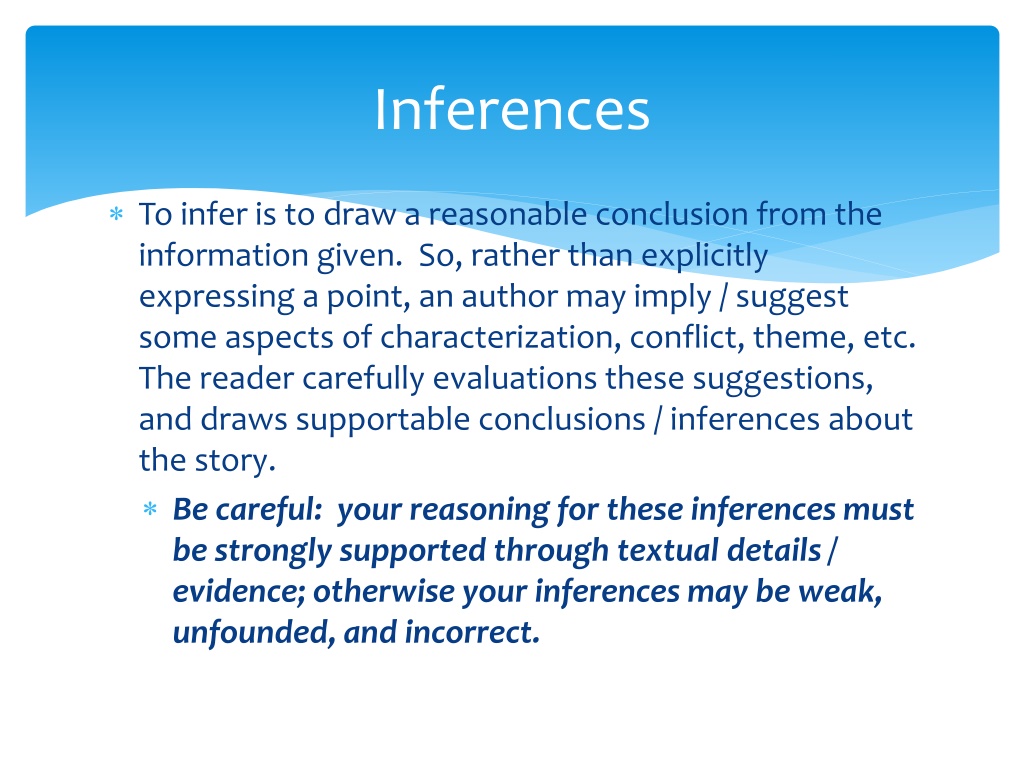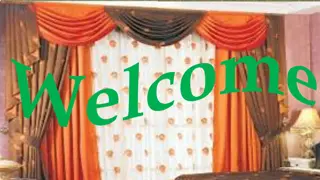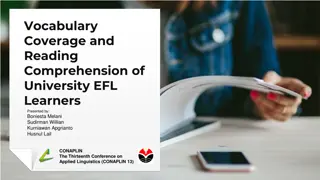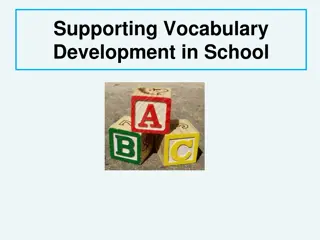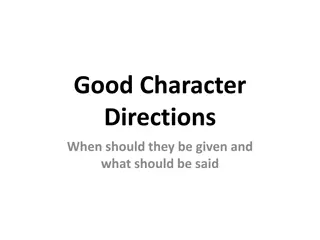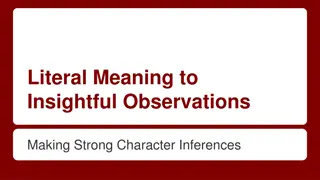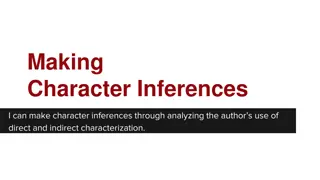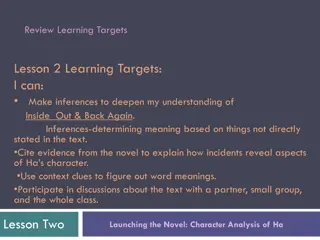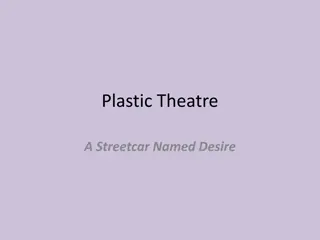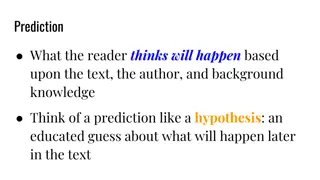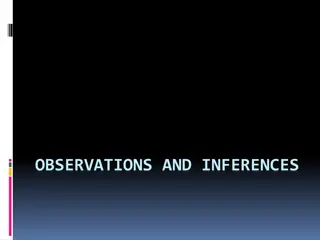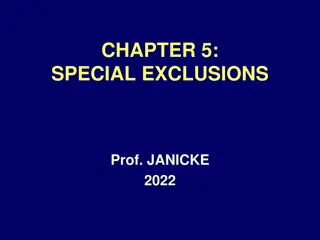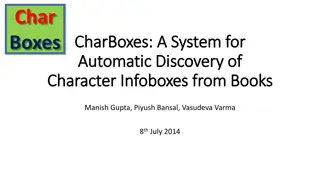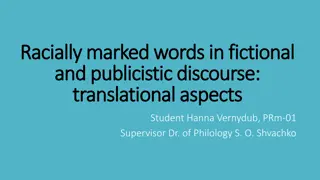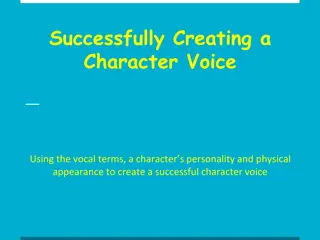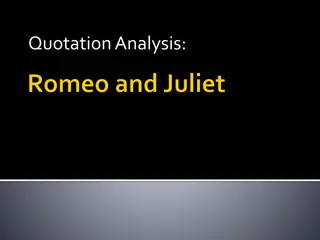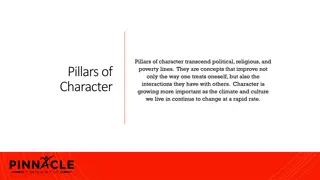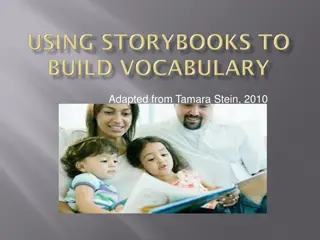Understanding Literary Elements: Inferences, Vocabulary, and Character Development
Inferences involve drawing conclusions from implied information; vocabulary in context aids in understanding unfamiliar words; juxtaposition compares or contrasts elements; characterization and character development reveal a character's traits and growth; static characters remain unchanged, while dynamic characters evolve throughout a story.
Download Presentation

Please find below an Image/Link to download the presentation.
The content on the website is provided AS IS for your information and personal use only. It may not be sold, licensed, or shared on other websites without obtaining consent from the author. Download presentation by click this link. If you encounter any issues during the download, it is possible that the publisher has removed the file from their server.
E N D
Presentation Transcript
Inferences To infer is to draw a reasonable conclusion from the information given. So, rather than explicitly expressing a point, an author may imply / suggest some aspects of characterization, conflict, theme, etc. The reader carefully evaluations these suggestions, and draws supportable conclusions / inferences about the story. Be careful: your reasoning for these inferences must be strongly supported through textual details / evidence; otherwise your inferences may be weak, unfounded, and incorrect.
Vocabulary in Context http://www.mc.cc.md.us/faculty/~steuben/public_html/vocabularycontext.htm Context clues are words and phrases in a sentence which help you reason out the meaning of an unfamiliar word. Oftentimes you can figure out the meanings of new or unfamiliar vocabulary by paying attention to the surrounding language.
Juxtapose / Juxtaposition To juxtapose is to place side by side or close together, especially to compare or to contrast.
Character Development / Characterization Characterization: The author's expression of a character's personality through the use of physical description, action, dialogue, thought, or commentary by the narrator or another character. (Purdue Owl) Character Development: the character s progress and growth throughout the story
Character Traits Elements of a character s personality that define the nature of the character.
Static Characters A static character does not change throughout the story. His or her personality remains the same from the beginning through to the end of the story. These are typically minor, flat characters. Flat characters possess simple personalities. They are typically described as possessing one-dimensional personalities.
Dynamic Characters Dynamic Characters change during the course of the story. The dynamic character grows emotionally, changes personality, or re-thinks his/her perspective on life as a result of learning through experiences / events in the story. Dynamic characters are typically major, round characters. Round characters possess a complex, three- dimensional personality.
Protagonist A protagonist is considered to be the main character or lead figure in a story. Typically, there is one central figure in a story the one spotlighted throughout the tale. However, some stories include multiple main characters.
Antagonist http://www.uncp.edu/home/canada/work/allam/general/glossary.htm#s The antagonist is a character or force in a story who deceives, frustrates, or works against the main character, or protagonist, in some way.
Theme http://www.uncp.edu/home/canada/work/allam/general/glossary.htm Theme is a common thread emphasized in the writing. The author will craft the theme through the use of characters, plot, setting, and various literary devices. Significantly, theme involves central messages in the writing, and therefore stems from author s purpose. There may be multiple central / main themes, as well as underlying or minor themes.
Setting http://www.uncp.edu/home/canada/work/allam/general/glossary.htm#s Consider the purpose and significance of the setting in a story. Setting is the time, place, physical details, and circumstances in which a situation occurs. This includes the environment in which the characters exist, and the physical details of the surroundings. The author may develop the setting in order to draw the reader into the writing, to aid in the development of characters, or to develop conflict in the story. Setting often plays a significant role in developing theme, as well.
Setting Aspects Consider all aspects of setting when analyzing this element: Mental (Historical Time Period, Culture, Social attitudes, etc.) Physical (General Region, Climate/Weather, Nation, Season, Time of Day, and Physical State of the characters: youth, old age, sickness, etc.) Geographic (mountains, lake, deserts, swamps, etc.)
Imagery Imagery involvesthose words / details that create vivid images which are created through detailing aspects of the five senses
Mood http://rwc.hunter.cuny.edu/reading-writing/on-line/lit-terms.html Mood: The atmosphere that pervades a literary work with the intention of creating a certain emotion or feeling from the audience. In drama, mood may be created by sets and music as well as words; in poetry and prose, mood may be created by a combination of such elements as setting, imagery, and theme.
Irony What are the three forms of irony?
Irony Verbal Irony: Sarcasm; you say one thing but mean the opposite. The irony of her reply, How nice! when I said I had to work all weekend. Situational Irony: An outcome of events contrary to what was, or might have been, expected. (the opposite of what you think is going to happen). Dramatic Irony: The reader/audience knows something that a character does not know
Conflict Internal: in literature - a struggle which takes place in the character's mind and through which the character reaches a new understanding or dynamic change. http://dictionary.reference.com/browse/internal+conflict
Conflict External: in literature - a struggle between a character and some outside force Character vs. Character Character vs. Nature Character vs. Society http://dictionary.reference.com/browse/external+conflict
Gustav Freytag was a Nineteenth Century German novelist who saw common patterns in the plots of stories and novels and developed a diagram to analyze them. He diagrammed a story's plot using a pyramid like the one shown here: http://oak.cats.ohiou.edu/~hartleyg/250/freytag.html
Exposition & Inciting Incident http://oak.cats.ohiou.edu/~hartleyg/250/freytag.html Exposition: setting the scene. The writer introduces the characters and setting, providing description and background. Inciting Incident: something happens to begin the action. A single event usually signals the beginning of the main conflict. The inciting incident is sometimes called 'the complication'.
Rising Action and Climax http://oak.cats.ohiou.edu/~hartleyg/250/freytag.html Rising Action: the story builds and gets more exciting Climax: the moment of greatest tension in a story. This is often the most exciting event. It is the event that the rising action builds up to and that the falling action follows.
Falling Action and Resolution http://oak.cats.ohiou.edu/~hartleyg/250/freytag.html Falling Action: events happen as a result of the climax and we know that the story will soon end. Resolution: the character solves the main problem/conflict or someone solves it for him or her.
Storys Use of Time: Chronological and Flashback Chronological: The story s key events are presented as they occur. A flashback is a narrative technique that allows a writer to present past events during current events, in order to provide background for the current narration. By giving material that occurred prior to the present event, the writer provides the reader with insight into a character's motivation and or background to a conflict. This is done by various methods, narration, dream sequences, and memories (Canada). http://www.courses.vcu.edu/ENG-jeh/BeginningReporting/Writing/storystructure.htm http://www.uncp.edu/home/canada/work/allam/general/glossary.htm
Foreshadowing The author hints or suggests what is to come later in the story
Perspective / Point of View http://dictionary.reference.com/ 1. a position from which someone or something is observed (the manner something is considered or evaluated) - from the point of view of a doctor. 2. an opinion, attitude, or judgment - He refuses to change his point of view in the matter. 3. the position of the narrator in relation to the story - (examples: first person, third person, limited, omniscient).
Perspective / Point of View http://www.uncp.edu/home/canada/work/allam/general/glossary.htm http://academic.brooklyn.cuny.edu/english/melani/pv.html First Person: The main character describes the experiences he or she encounters, and gives the reader insight into his or her thoughts, feelings, intentions, and personality (Canada). Second Person: Second person is unusual in fiction and is more common in poetry. In second person, the character is not referred to as he or she, or by name, but rather as you. For example, the story may include: You, a boy of ten, who woke from a terrible dream, to find your body shaking and cold. http://owl.english.purdue.edu/owl/resource/754/02/
Perspective / Point of View http://www.uncp.edu/home/canada/work/allam/general/glossary.htm http://academic.brooklyn.cuny.edu/english/melani/pv.html Third Person Omniscient: In this style, the narrator is all knowing and moves from one character to another as necessary to provide those characters motivations and emotions (Canada). Third Person Limited: The narrator focuses typically on one character (potentially two), sharing thoughts and feelings of that one figure in the story.
Symbol A symbol is a person, place, or object that has a concrete meaning in itself, and also stands for something beyond itself. For example, the changing seasons often symbolize the passing of time: spring represents new life / birth; summer represents youth; autumn represents adulthood; and winter represents death.
Allusion Allusion a reference, explicit or implicit, to something in previous literature and history The girl's love of diamonds was her Achilles heel. http://www.buzzle.com/articles/allusion-examples.html
Comparisons Simile comparison of two unlike objects using like or as Metaphor- comparison of two unlike objects Extended Metaphor a metaphor that is extended, or developed, over several lines or throughout a poem/piece Personification (metaphoric); a nonhuman element is given human-like qualities (the arms of the tree reach for the sky)
Tone http://rwc.hunter.cuny.edu/reading-writing/on-line/lit-terms.html Tone - the attitude of an author toward his or her subject matter and / or audience. Tone is often connected with the voice of the writing.
Elements of Tone When analyzing Tone, consider diction (word choice), as well as syntax (sentence structure) Regarding Diction, be aware of the dual aspects of words: Denotation: the explicit or direct meaning of a word Connotation: the associated or secondary meaning of a word
Hyperbole / Exaggeration Hyperbole/exaggeration 1. obvious and intentional exaggeration. 2. an extravagant statement or figure of speech not intended to be taken literally, as to wait an eternity. http://dictionary.reference.com
Understatement Understatement: the act or an instance of stating something in restrained terms, or as less than it is A form of irony in which something is intentionally represented as less than it is: Hank Aaron was a pretty good ball player. http://dictionary.reference.com
Allegory A narrative that serves as an extended metaphor The characters, settings, and objects have both literal and figurative / symbolic meanings.
Onomatopoeia Onomatopoeia: 1. the formation of words whose sound is imitative of the sound of the noise or action designated, such as hiss, buzz, and bang 2. the use of such words for poetic or rhetorical effect * From the Greek: to make words http://dictionary.reference.com
Repetition Repetition: The repetition of words / phrases is called anaphora The repetition of sentence structure / phrasing involves parallel structure: using the same pattern of words to show that two or more ideas have the same level of importance The repetition of letter sounds in words (typically the beginning of words) close to one another is called alliteration Overall, repetition helps to create a flow in writing, and can be used to emphasize content
Alliteration Consonance: The repetition of similar consonant sounds Assonance: The repetition of similar vowel sounds
Rhyme Rhyme:the repetition of similar sounds. In poetry, the most common kind of rhyme is end rhyme, which occurs at the end of two or more lines. Internal rhyme occurs in the middle of a line, as in these lines from Coleridge, "In mist or cloud, on mast or shroud" or "Whiles all the night through fog-smoke white" ("The Ancient Mariner"). There are many kinds of end rhyme: True rhyme is what most people think of as rhyme; the sounds are nearly identical--notion, motion, potion, for example. Weak rhyme, also called slant, oblique, approximate, or half rhyme, refers to words with similar but not identical sounds, e.g., notion-nation, bear-bore, ear-are. Emily Dickinson frequently uses partial rhymes. Eye rhyme occurs when words look alike but don't sound alike--e.g., bear- ear. http://academic.brooklyn.cuny.edu/english/melani/lit_term.html
Modes of Writing Narrative: Telling a story. These writings are often anecdotal (story of a personal event/occurrence), experiential, and personal (http://owl.english.purdue.edu/owl/resource/685/04/) Persuasive: Persuasive writing intends to influence how someone thinks, feels, acts, and makes decisions in relation to a particular issue, idea, or proposal. The writer is making a case and using language in a deliberative manner. Persuasive writing can lead to decisions, clarification of issues or positions, and consensus. (http://www.principiacollege.edu/current-students/writing-center/faculty/phase-3-wrp-persuasive-writing-course/what-persuasive-writin) Expository: A type of writing used to explain, or to inform (http://www.stanford.edu/~arnetha/expowrite/info.html)
Modes of Writing Descriptive: A description paper often takes a person or object and then describes that person or thing in great illustrative detail. For example, a description paper about a close friend might describe his or her appearance, her actions, and her personality, both through direct descriptive words--like paintings of her in different situations--and through stories showing him in action. (http://www.tc.umn.edu/~jewel001/CollegeWriting/START/Modes.htm#Description)
Modes of Writing Cause and Effect: Cause and effect papers use analysis to examine the reasons for and the outcomes of situations. They are an attempt to discover either the origins of something, such as an event or a decision, the effects or results that can be properly attributed to it, or both. (http://www.butte.edu/departments/cas/tipsheets/style_purpose_strategy/cause_effort.html) Literary Analysis: A literary analysis is not a summary of a literary work. Instead, it is an argument about the work that expresses a writer s personal perspective, interpretation, judgment, or critical evaluation of the work. This is accomplished by examining the literary elements and devices, word choices, and/or writing structures the author uses within the work. The purpose of a literary analysis is often to demonstrate why the author uses particular elements in order to convey his or her message. (www.germanna.edu/tutor/handouts/english/literary_analysis)
Purpose The Goal The reason behind the text What do I want my audience to think or do as a result of reading my text? What you hope to accomplish by this expression of opinion. How would you like your audience to respond?
Genre Traits Long and Short Fiction POV, characterization, plot, setting, tone, mood, literary devices Extension of the elements in lengthier fiction pieces More limited / abbreviated elements in short fiction pieces
Genre Traits - Nonfiction Nonfiction with an emphasis on facts include essays, letters, editorials, news articles, biographies, autobiographies, textbooks, and focused topic books. Creative Nonfiction includes feature articles, memoirs, narrative and reflective essays, literary journalism, profiles, brochures, ads. There is a concentration on persuasion, analysis, and reflection. SOAPStone (Speaker [persona], Occasion, Audience, Purpose, Subject, Tone) Bias Text Features (headings, photos, captions, fonts) In argument / claim focus pieces: writers include personal anecdotes, historical / current evidence, and/or expert testimony to aid in support of claim/purpose.
Genre Traits - Poetry POV: there is typically a speaker or persona crafted; sometimes the poet speaks directly in poem. Setting Physical Structure of poem (rhyme, rhythm, line breaks) Tone and Mood Literary Devices: compact nature of poem and this impact upon expression/development of devices
Genre Traits - Drama Dialogue Stage Directions Props Typical / Atypical narrator commentary
Thesis Statement A thesis statement / claim statement is a proposal, argument, or theory tells the reader how you will interpret the significance of (analyze) the subject matter is a road map/outline for the paper directly answers the question/prompt. A thesis is an interpretation (analysis) of a question or subject, not the subject itself. For Example: The subject, or topic, of an essay might be World War II or Moby Dick; a thesis must then offer a way to understand the war or the novel. is usually a single sentence at the end of your introduction The rest of the paper, the body of the essay, gathers and organizes evidence that will persuade the reader of the logic of your thesis/argument/analysis. adapted from http://www.unc.edu/depts/wcweb/handouts/thesis.html
Topic Sentence Every paragraph should include a topic sentence that identifies the main idea of the paragraph. A topic sentence also states the point the writer wishes to make about that subject. The topic sentence appears at the beginning of the paragraph as the paragraph s very first sentence. A paragraph s topic sentence must be general enough to express the paragraph s overall subject. But it should be specific enough that the reader can understand the paragraph s main subject and point. Adapted from http://owl.english.purdue.edu/engagement/index.php?category_id=2&sub_category_id=1&article_id=29
MLA Format for Embedding and Citing Quotations To embed a quotation is to make the quotation a part of your writing a part of your sentence. Consider three important steps in the embedding process: 1. Introduce your quotation. This introductory sentence sets the stage for the upcoming quotation. The introductory sentence tells the reader such points as what is happening in the story at the point that the quotation is taken, or a general idea of the situation in which the quotation exists.
